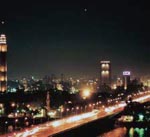Oh tut!
We saw the Pyramids and clicked snaps with the Sphinx. But that’s definitely not all that we did in Tutankhamun’s Egypt.

We saw the Pyramids and clicked snaps with the Sphinx. But that’s definitely not all that we did in Tutankhamun’s Egypt.

CAIRO

Cairo
The Mummy Returns: Neither Khufu’s nor Cheops’ pyramids are the oldest structures in and around Cairo. For that, we went on a short drive through picturesque palm and date tree-lined roads to Saqqara, the site of the Step Pyramid of Zoser. The exterior is a bit damaged because of years of neglect (it lay buried for many centuries and sands have eroded part of the structure) but the artwork in the underground tombs are more impressive than the Cheops Pyramid.
Just a note of caution: Reach early as the place closes at 4 p.m. We reached early, well before noon and, therefore, could walk around the site before the sun blazed in all its glory. Guides, of course, will remind you that Zoser and his legend inspired Hollywood hits The Mummy and The Mummy Returns.
Open: 8 a.m. to 4 p.m.
Entry: 50 Egyptian pounds (Rs 400) for the Saqqara complex.
Shoppers’ stop: Unless you don’t believe in spending money, the first thing you should buy in Egypt is an authentic papyrus

Khan-el Khalili Bazaar
If you’re keen on shopping for exotic Egyptian artefacts, then the Khan-el Khalili Bazaar is an absolute must-visit. It is a warren of winding streets and twisting alleyways with an amazing number of shops and carts. Be prepared to bargain shamelessly,

Finishing touches on a papyrus scroll
Where: Next to Al Azhar Street. Every driver in Cairo knows where it is.
Look up: www.virtualkhan.com, not to buy on the web, but to check the range of products you can shop for, once you walk into the market.
King tut’s riches: The biggest single attraction within the city for tourists is the Egyptian Museum. The sprawling sandstone

Tutankhamuns gold coffin
Where: The National Museum, Tahrir Square,Cairo
Entry: A basic ticket costs 20 Egyptian pounds (Rs 160) per adult. The Mummy room has a special ticket for 40 Egyptian pounds (Rs 320). Children get a 50 per cent discount on all tickets. There is a onetime charge of 10 Egyptian pounds (Rs 80) for clicking photographs (flashguns are not allowed)

Cairo by night
Visit the Casino Semiramis at the Semiramis Intercontinental Hotel or the Crazy House Exit to get an eyeful of exotic dancers and live salsa performances while you try your luck at blackjack.

Tutankhamuns gold throne
Look Up: www.lonelyplanet.com/worldguide/egypt/cairo/entertainmen
ON THE NILE

A luxury cruise ship
Kom ombo: While Luxor overawed us and the Colossi of Memnon got the cameras out as well, the temple at Kom Ombo stood out. This unusual double temple built during the Ptolemaic dynasty is dedicated to two Gods—the crocodile god Sobek Re, god of fertility and creator of the world, and the falcon god Haroeris. Much of the temple has been destroyed by the Nile, earthquakes and later builders who used the stones for other projects.

Relief work at Kom Ombo temple
Where: On the River Nile, 45 km north of Aswan
Open: Daily 7 a.m.-5 p.m.
Entry: Approximately Egyptian pounds 20-25 (Rs 162-202) per person
Island Of Philae: The final day of any cruise is usually reserved for the best and our luxury Nile cruise followed the norm. Early in the morning, we woke up to see this magical island, almost rising out of the clear blue waters of the Nile. You will have to take a felucca (sail boast) to reach the nearly submerged Island of Philae. The temples here were begun by Ptolemy II and completed by the Roman emperors and were nearly lost under water when the high Aswan dam was built in the 1960s. Fortunately, it was rescued by a joint operation between the Egyptian government and UNESCO. Take our tip and visit this amazing piece of architecture before nature takes its toll.
Where: Near Aswan Best Time to Visit: Early morning
Entry: Felucca rides are complimentary with most cruises
The Magical Show: Of course, if all these majestic sites do not satiate your appetite, then may we suggest the piece de

Son et Lumiere at Giza
Where: The Pyramids at Giza
Time: Shows in Arabic, French and English at intervals of 70 minutes after sunset
Price: Approximately 60-70 Egyptian pounds (Rs 480-560) per person










